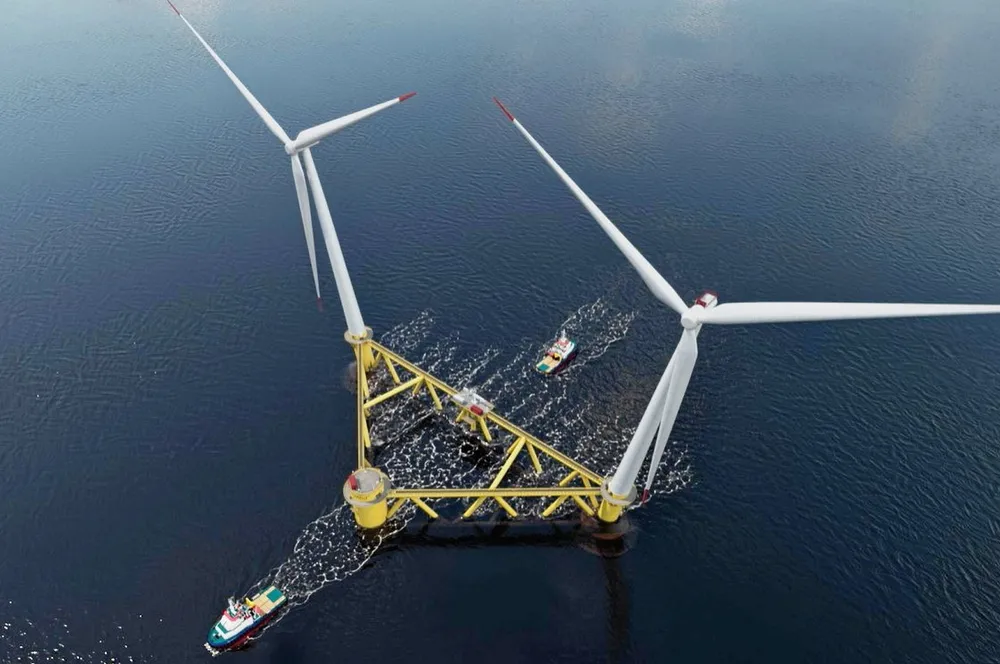Developer working with China's Mingyang on UK wind project says 'benefits outweigh risks'
Hexicon has slowed the pace of the TwinHub floating project as it reassesses supply chain costs but values Chinese player as a partner not a rival

A twin-rotor floating wind demonstrator project that Hexicon is developing off the southwest of England is benefitting from the engineering experience of China's Mingyang Smart Energy, outweighing any potential risks in partnering with a potential rival, according to the head of the Swedish platform pioneer.
Mingyang was chosen to supply 8MW turbines, as well partnering Hexicon on engineering and design for the 32MW development.
The schedule for the project has been affected by the economic headwinds that have battered the offshore wind industry, in what Hexicon CEO Marcus Thor described as a "challenging year" for the sector.
"We have responded by reevaluating parts of the supply chain, including [transport and installation]. We are looking quite heavily into ports right now and continue to do so into autumn, evaluating the impact of the UK's (Floating Offshore Wind Manufacturing Investment Scheme FLOWMIS) awards," he said.
On the other hand, Hexicon, together with Mingyang and consultancy firm London Marine Consultants, has been making progress on what Thor called the key challenge of integrating the twin turbines with Hexicon's triangular TwinWind hull and its control systems.
"We have been working more on the more technical aspects of the project. We're a good way through with FEED working quite extensively with Mingyang on integrated load analysis," Thor says.
The twin rotor concept is still unproven in commercial application but tests have suggested that overall yields from a pair can be slightly higher when compared to a single floating wind turbine, provided control systems are deployed effectively.
Hexicon believes that growing pressure for seabed space and concerns over environmental impact also provide a strong business case for twin-rotor hull configurations.
“The cost of energy is vitally important, especially in today’s market where cost pressures are enormous, but we also see the reduction of impact to the environment and other stakeholders as a key driver for the twin rotor platforms," he says.
Put simply, the twin rotor concept squeezes more turbines into a given area.
This means less of a seabed footprint and less intrusion on a per megawatt basis, which Hexicon says makes it easier to coexist with stakeholders.
“Perhaps, the idea of squeezing in as much as possible into the area has not been on the top of developers' priority lists, but it's already happening in some markets where there's really not unlimited areas available for offshore wind development. I'm pretty convinced that factor will grow as developments continue," Thor comments.
Mingyang know-how
OceanX features a V-shaped tower structure, with each of the two towers carrying a Mingyang MySE8.3-180 semi-direct-drive turbine, giving the entire platform a combined capacity of 16.6MW.
“I think the benefits outweigh the risks and downsides here. [Mingyang] has experience of integrating the turbine and actually deploying a twin rotor system. They’ve seen the risks, they’ve actually done it before and I think we can really benefit from that,” he says.
In an presentation to investors and analysts earlier this year, Thor described this integrated work between turbine and the foundation suppliers as "the key to success".
"It is truly exciting for our engineers to ensure that the whole twin rotor system working as one system as confirmed by the turbine suppliers," he stated.
'We can go big'
Hexicon’s technology will also be used with twin 8MW turbines in the UK, but Thor stressed that the company's own design could also house much bigger machines.
"More investigation is needed to find the optimum arrangement for a twin rotor. So far we’ve worked extensively with turbines up to and including 18MW," he says.
"There are not technical constraints to working with larger turbines but my personal opinion is that turbines have grown so quickly that it presents problems as supply chains and ancillary services try to keep up."
Thor was also upbeat about the productivity benefits of a twin rotor system if, for example, a configuration of two 8MW turbines are compared with a single 16MW machine, but he acknowledges that getting alignment, rotation and realignment right is a complex task.
"We are seeing a slight increase in yield but to be sure that there aren't any negative consequences, we've done a great deal of work ourselves and with universities," he says.
"The challenge is to really capture and capitalise this potential to ensure the optimisation of the two rotors as one system... we need to ensure that this system is controlled to achieve the maximum yield as a system and not each individual turbine."
As well as working on its platform design Hexicon is an offshore wind developer, and says it pursues opportunities on a technology-neutral basis.
Among the company's flagship projects are the 1.25GW MunMubaram project in South Korea where it recently agreed to acquire Shell's 80% stake and is now engaged in a process find new partners.
Thor describes the agreement with Shell as a "very favourably priced for a substantial opportunity".
He argues that Korea's certificate scheme, which rewards developers for distancing themselves more from the shore and going into deeper waters, shows the direction of travel when it comes to competition for seabed acreage.
"This government-backed subsidy is a sweet spot for floating wind and is a clever way of avoiding conflict with other activities, like fishing, boating, shipping," he states.
Thor admits that Hexicon's growing focus on regulatory approvals in Korea and the presence of highly developed shipbuilding and offshore supply chain industries in that country, provides part of the explanation for the supply chain reassessment in the UK. "We are looking beyond the UK project," he says.
Hexicon currently has a net 13GW offshore wind pipeline with projects in Sweden, Korea and Italy most advanced.
(Copyright)